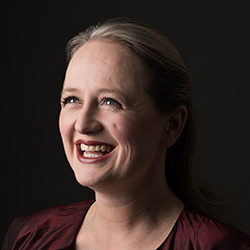
Miriam Allan & Erin Helyard
On Wednesday 21 September, Miriam Allan and Erin Helyard take to the Elisabeth Murdoch Hall stage to perform works by Haydn, Mozart and more as part of Melbourne Recital Centre's Great Performers series. Explore the program in this excerpt from the official program notes, written by Phillip Sametz.
About the music
Schubert, for many music-lovers, is the supreme composer of the German art song, and Haydn the inventor of the symphony and the string quartet. But the song which opens tonight’s recital might make you wonder whether we have judged Haydn fairly. You might also wonder how it was that Haydn created so many songs to English texts – and why these songs are not better known.
In a way, there is one answer to both questions. The songs date from the years of Haydn’s personal freedom – that is, the years after his employer, Prince Nikolaus Esterházy, died, and his successor, his far less musical son Anton, allowed the composer to freelance. So it was that in the early 1790s Haydn sailed to London (seeing the sea for the first time – at the age of 58) for the first of two visits there, and began the rich, final phase of his composing life, which would encompass the oratorios The Creation and The Seasons, his 12 London Symphonies, the string quartets Op. 71 and 74 and much else besides – including the songs you hear this evening.
All but one of these songs has a text by Anne Hunter. Anne’s husband John was the surgeon and scientist John Hunter, whose anatomical collection would become the basis of London’s Hunterian Museum. The well-connected couple became friendly with Haydn, to the point where Anne presented Haydn with some of her poems, which he set to music in Vienna between his London trips. They were published as part of two sets of Canzonettas, intended for the domestic market – and it’s likely that the use of these songs in the home by amateur musicians prevented them becoming better known. But there is an exception which proves the rule – A Pastoral Song (My mother bids me bind my hair), which has been performed by singers down the ages – from Jenny Lind to Joan Sutherland.
The other outlier here is the only song without a Hunter text; She never told her love comes from Shakespeare’s most ‘musical’ play, Twelfth Night. Although the play contains several songs, Haydn chose to set a short monologue by Viola (I told you the play was musical) in which, disguised as a man, she uses pointed metaphors to express her love for Duke Orsino (‘let concealment, like a worm in the bud, Feed on her damask cheek’).
In its ability to convey a world of feeling in just a few minutes, you might argue that this song (along, perhaps, with The Wanderer) is the one in which Haydn most palpably anticipates Schubert’s achievements. Then again, as the late musicologist Bruce Brown once argued, Haydn and Mozart did not get up in the morning to forbear. However many lines you try to draw back from Schubert to his predecessors, the consistent richness of his musical ideas and his sensitivity to text set him apart from other songwriters who preceded and overlapped with him. And there were many of these; it’s not that Schubert sprang from nowhere but that the song composers from whom he learned so much are barely performed today – Zelter, Zumsteeg and Reichardt among others. There’s also the chronological fact that by 1817, when Beethoven’s song cycle An die ferne Geliebte was published, Schubert had already composed dozens of songs, including Gretchen am Spinnrade, Erlkönig and three that you’ll hear tonight.
As writer John Warrack puts it, Schubert’s understanding of the ‘connection between a verbal image and the poem’s expressive mood’ was unique and catches the heart in even the most seemingly straightforward of his songs. In two of the earliest lied on tonight’s program, Seligkeit and Minnelied (both 1816), the friskiness of the text finds an echo in the music’s joyful dance. In Trauer der Liebe (also 1816), the singer’s longed-for reunion with her beloved (‘Where has any trace of you remained, beauteous love?’) is met with a wistful melodic turn – like a gathering of thoughts – from the keyboard between each verse. The almost supernatural serenity of Du bist die Ruh (1823) sounds like simplicity itself; as Schubert scholar Maurice J.E. Brown said, ‘its accompaniment could hardly use fewer notes’, but sustaining the song’s rapt atmosphere places great demands on the singer. The silvery, rippling figure which opens Auf dem Wasser zu singen (1823) seems to welcome in the first line of the text – ‘Amid the shimmer of the mirroring waves’ – while it’s hard to imagine a songfulness as expressive as that of Ständchen (1828), later part of the compiled song-cycle Schwanengesang. This is one of Schubert’s most famous songs, and its powerful yearning (‘Beloved, hear me! Trembling, I await you!’), coming as it does from the final year of his life, makes it especially poignant. This is, after all, the composer who once confessed to his diary: ‘What I produce is due to my understanding of music and to my sorrows.’
Although we often think of Chopin – in his Nocturnes, Scherzi, Impromptus and much more – as creating a revolution in descriptive piano music by breaking free of classical forms, Schubert’s smaller keyboard works also constitute the emergence of a new voice in the world of musical Romanticism. If the piano sonatas find Schubert bringing his own aesthetic to a keyboard tradition exemplified by the work of Haydn, Mozart and Beethoven, the six Moment musicaux are Schubert’s analogue to the world of romantic poetry. These are mood pieces (‘musical moments’ in every sense) which anticipate by decades music as varied as Liszt’s Liebestraum and Brahms’ Intermezzi. The second of them is an example of that songful melancholy which runs like a thread through so much of Schubert’s later music. The jaunty third bears a striking resemblance to the opening of Schubert’s Ballet No. 2 for Rosamunde, while the fourth begins and ends with a gentle momentum which is punctuated, in the central section, by a halting, reticent lyricism. Dating these pieces accurately is difficult, as the manuscript has not survived. They were not published as a set until the year of the composer’s death, 1828, but two of them (including the Third) had been published a few years earlier. Scholars now believe Schubert had finished the set by the end of 1827, which means he would have composed the third of these pieces around the same time as he was writing his Rosamunde music.
So to the variations by Mozart and his talented pupil. The Mozart work is a musicological minefield, because although it seems like a transcription for solo piano – by Mozart himself – of the finale of his sonata (or really duo) for violin and piano in F, K.547, some pianists play what you hear tonight as the finale of the keyboard sonata K.547a – which was published after Mozart’s death and cobbled together from other Mozart compositions. In the early 20th century an autograph was discovered of these Six Variations on an Original Theme, but with some pages missing; since then the work’s place in the Mozart catalogue has shifted several times, as scholarly opinion about its provenance – and even its authenticity – has changed. At different times the work has been designated as K.54, K.Anh 138a (‘Anh’ indicating an appendix to the catalogue, the equivalent of a work’s doubtful origins dooming it to the outer darkness) and, most recently, K.547b. This short work is delicate and charming, and in its carefree manner recalls the Mozart of the Serenades.
The intricate, delightful variations on Papageno’s entrance aria (The Bird catcher’s Song) from The Magic Flute are by one of Mozart’s most celebrated pupils, Josepha Auernhammer. In June 1781, Mozart wrote: ‘I dine almost daily with [her]; the young lady is a fright, but plays enchantingly, though in cantabile playing she has not got the real delicate singing style. She clips everything’. It seems that she was in love with him; whatever the nature of their relationship, Mozart dedicated several works to her, and they gave concerts together.
These variations are witty, inventive and full of surprises, as Auernhammer takes Mozart’s melody into unexpected keys, decorates it elaborately and, in perhaps the most striking moment of all – in the penultimate variation – takes it from major to minor. The work first saw the light of day a year after Mozart’s death, in 1792.

About the Artists
Miriam Allan
Miriam Allan is one of the world’s leading sopranos. Her tonal beauty and breathtaking technique have been enjoyed across the world. Eminently suited to the chamber format, Miriam’s voice is light, clear and delivered with a groundswell of emotional depth.
oprano Miriam Allan has been enjoyed across the world, notably during the funeral of HRH Prince Philip, Duke of Edinburgh.
Recent performances have seen her debut with Collegium Vocale Gent and their director Philippe Herreweghe in concerts and recordings; a debut with the London Philharmonic Orchestra; concerts with La Nuova Musica and the English Concert at London’s Wigmore Hall; and semi-staged concerts with Early Opera Company at St John’s Smith Square, London. Miriam continues her long association with Les Arts Florissants in concerts and recording in France and around Europe and the USA.
On the opera stage she is a regular principal with Pinchgut Opera, alongside appearances at the Innsbruck Festival, Glyndebourne Festival Opera, Opera Comique, Paris, and Brooklyn Academy of Music, New York as well as appearances in Mozart Opera Galas at the Royal Opera House, Covent Garden and Salle Pleyel, Paris.
Frequent collaborators include Sir John Eliot Gardiner, Masaaki Suzuki and William Christie, whilst she has sung with the BBC Philharmonic, Melbourne Symphony, Orchestra of the Age of Enlightenment and Aurora Orchestra.

Erin Helyard
Melbourne Recital Centre’s 2022 Artist in Residence and Artistic Director of Pinchgut Opera Erin Helyard is acclaimed as an inspiring conductor and a virtuosic and expressive performer of the harpsichord and fortepiano. He is passionate about music of the past and the discourse between musicology and performance.
Erin graduated in harpsichord performance from the Sydney Conservatorium of Music with first-class honours and the University Medal. He completed his Masters in fortepiano performance and a PhD in musicology with Tom Beghin at McGill University, Montreal.
As Artistic Director and co-founder of the celebrated Pinchgut Opera and the Orchestra of the Antipodes (Sydney) he has forged new standards of excellence in historically informed performance in Australia. Pinchgut Opera won Best Rediscovered Opera (2019) for Hasse’s Artaserse at the International Opera Awards in London.
Operas under his direction have been awarded Best Opera at the Helpmann Awards for three consecutive years (2015-2017). He has received two Helpmann Awards for Best Musical Direction: one for a fêted revival of Saul (Adelaide Festival) in 2017 and the other for Hasse’s Artaserse (Pinchgut Opera) in 2019. Together with Richard Tognetti, Erin won an ARIA for Best Classical Album in 2020.
Program note excerpt by Phillip Sametz.
Tickets to Miriam Allan and Erin Helyard's Great Performers recital are available here.
You might also be interested in
-
-
-
Explore the program notes in advance

